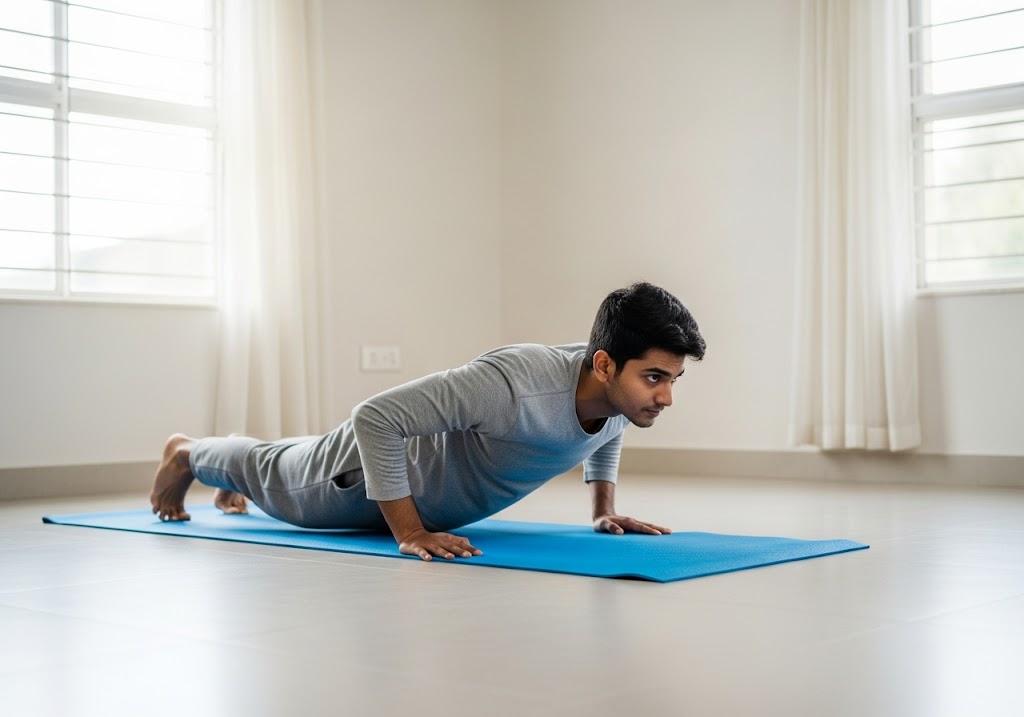How many crunches per day? Perform 50-100 crunches per day for general fitness and core strength, with beginners starting at 20-30 daily and advanced trainees handling 200-300 based on conditioning level.
Want to know exactly how many crunches per day you need to build strong abs and achieve your fitness goals? The answer depends on your current fitness level, specific objectives, and training experience. Beginners should start with 20-50 crunches per day, while intermediate and advanced individuals can perform 100-300 crunches daily for optimal core development and strength building.
Understanding how many crunches per day for abs development requires considering factors like proper form, progressive overload, and individual recovery capacity. Whether you’re targeting how many crunches per day for flat stomach results or focusing on how many crunches per day to get abs, this complete plan provides structured guidance for safe and effective core training that delivers real results.
Table of Contents
How Many Crunches Per Day?
Determining how many crunches per day you should perform depends on your fitness level, goals, and current core strength. Most fitness experts recommend starting with manageable numbers and gradually increasing volume to prevent overuse injuries while building sustainable exercise habits for long-term success.
| Fitness Level | Daily Crunches | Sets | Reps per Set | Focus Area |
| Beginner | 20-50 | 2-3 | 10-20 | Form learning |
| Intermediate | 75-150 | 3-4 | 20-40 | Strength building |
| Advanced | 200-300+ | 4-6 | 40-60 | Endurance/Definition |
| General Fitness | 50-100 | 3 | 15-35 | Core strength |
| Athlete | 150-250 | 4-5 | 30-50 | Performance |

How Many Crunches Per Day for Beginner?
Beginners wondering how many crunches per day for beginner routines should start with modest numbers to build foundational strength and proper movement patterns. Starting too aggressively often leads to poor form, muscle soreness, and decreased motivation to continue with consistent training efforts.
New exercisers should begin with 20-30 crunches per day, focusing entirely on perfect form and controlled movements rather than speed or quantity. This approach builds proper muscle activation patterns while allowing your core muscles to adapt gradually to the new training stimulus without excessive fatigue or soreness.
| Week | Daily Crunches | Focus | Sets | Rest |
| 1-2 | 20-30 | Form learning | 2-3 sets | 60 seconds |
| 3-4 | 30-50 | Strength building | 3 sets | 45 seconds |
| 5-6 | 50-75 | Endurance | 3-4 sets | 30 seconds |
| 7-8 | 75-100 | Progression | 4 sets | 30 seconds |
For comprehensive beginner fitness routines, bodyweight exercises for beginners provides excellent foundational movements that complement core training.
How Many Crunches Per Day for Abs?
Understanding how many crunches per day for abs development requires recognizing that visible abs depend more on low body fat percentage than exercise volume alone. However, consistent crunch training builds the underlying muscle mass and strength needed for impressive abdominal definition.
| Goal | Daily Crunches | Body Fat Target | Timeline | Additional Requirements |
| Basic Abs Strength | 100-150 | N/A | 4-6 weeks | Proper form focus |
| Visible Upper Abs | 150-200 | Men: <15%, Women: <22% | 8-12 weeks | Diet + cardio |
| Six-Pack Definition | 200-300 | Men: <12%, Women: <18% | 12-16 weeks | Strict nutrition |
| Competition Ready | 300+ | Men: <10%, Women: <16% | 16-24 weeks | Professional guidance |
| Maintenance | 100-150 | Maintain low BF% | Ongoing | Consistent habits |
For comprehensive core development, how to do plank exercise provides excellent complementary exercises that enhance overall abdominal strength and stability. Additionally, how to get a six pack quick offers comprehensive strategies for accelerated abs development.
How Many Crunches Per Day for Flat Stomach?
Many people ask how many crunches per day for flat stomach results, but achieving a flat stomach requires combining core exercises with overall fat loss through diet and cardiovascular exercise. Crunches alone cannot eliminate belly fat, but they strengthen and tone the underlying muscles.
For flat stomach goals, combine 75-150 crunches per day with regular cardio exercise and proper nutrition for optimal results. This approach addresses both muscle development and fat loss necessary for achieving the flat, toned stomach appearance most people desire through comprehensive lifestyle changes.
The key to flat stomach success lies in understanding that spot reduction is impossible, meaning you cannot lose fat from specific areas through targeted exercises alone. However, strengthening your core muscles through consistent crunching creates better posture and muscle tone that contributes to a flatter appearance.
| Component | Daily Target | Purpose | Timeline |
| Crunches | 75-150 reps | Muscle building | 4-8 weeks |
| Cardio | 30-45 minutes | Fat burning | Ongoing |
| Diet | Calorie deficit | Fat loss | Ongoing |
| Water | 2-3 liters | Reduced bloating | Daily |
For additional core exercises that support flat stomach goals, how many calories can you burn doing crunches provides insights into the calorie-burning potential of abdominal training.
How Many Crunches Per Day to Lose Belly Fat?
Understanding how many crunches per day to lose belly fat requires recognizing that crunches don’t directly burn belly fat but strengthen underlying muscles. Fat loss occurs through creating calorie deficits via diet and full-body exercise rather than targeted spot reduction alone.
| Approach | Daily Crunches | Primary Focus | Expected Timeline | Success Factors |
| Fat Loss Only | 0-50 | Diet + Cardio | 8-16 weeks | Calorie deficit |
| Muscle + Fat Loss | 100-150 | Combined approach | 12-20 weeks | Balanced program |
| Comprehensive | 150-200 | Full body training | 16-24 weeks | Lifestyle change |
| Maintenance | 75-100 | Habit formation | Ongoing | Consistency |
| Quick Start | 50-75 | Building routine | 2-4 weeks | Form development |
For understanding exercise timing optimization, is it better to do cardio before or after weights provides guidance on structuring workouts for maximum fat loss results.

Proper Crunch Form and Technique
Regardless of how many crunches per day you perform, proper form remains crucial for effectiveness and injury prevention. Poor technique reduces muscle activation while increasing risk of neck strain and lower back problems that can derail your fitness progress.
Correct Crunch Execution
Lie on your back with knees bent and feet flat on the floor, hands supporting your head without pulling on your neck. Engage your core muscles and lift your shoulder blades off the ground using abdominal strength rather than momentum or neck flexion for optimal muscle activation.
Focus on slow, controlled movements with deliberate muscle contractions rather than rapid repetitions that rely on momentum. Each crunch should take 2-3 seconds up and 2-3 seconds down for maximum muscle tension and development.
- Starting Position: Lie flat with knees bent, feet planted firmly on ground
- Hand Placement: Support head lightly, avoid pulling on neck during movement
- Movement: Lift shoulder blades using core muscles, not momentum
- Breathing: Exhale during the lifting phase, inhale during lowering phase
- Range: Focus on quality contraction rather than maximum height achieved
- Control: Maintain tension throughout entire movement for best results
Common Form Mistakes
Pulling on the neck during crunches creates strain and reduces abdominal muscle activation while potentially causing injury. Keep hands supporting your head without creating tension or pulling motions that compromise proper movement patterns.
Using momentum to bounce through repetitions reduces muscle tension and effectiveness while increasing injury risk. Focus on deliberate, controlled movements that maintain constant muscle engagement throughout the entire range of motion for optimal results.
For additional core exercises that complement crunches, how many planks should i do a day provides guidance on isometric core training that enhances overall abdominal strength.
Benefits of Daily Crunches
Understanding the benefits of daily crunching helps maintain motivation and provides realistic expectations for your core training efforts. While crunches offer numerous advantages, they work best as part of comprehensive fitness programs rather than standalone solutions for complete fitness development.
- Core Strength Development: Regular crunching strengthens rectus abdominis muscles creating the “six-pack” appearance while engaging obliques and deep core muscles
- Improved Posture: Strong abdominal muscles support proper spinal alignment during sitting, standing, and movement activities while reducing lower back strain
- Enhanced Athletic Performance: Well-developed core strength improves power transfer between upper and lower body during sports and physical activities requiring coordination
- Functional Movement Support: Core strength from consistent crunching transfers to improved performance in lifting, running, cycling, and daily movement patterns
- Injury Prevention: Strong abs provide spinal support that reduces injury risk during lifting activities, sports participation, and demanding daily tasks
- Better Body Awareness: Regular core training improves proprioception and body control, enhancing balance and coordination in various physical activities
- Increased Muscle Endurance: Daily crunching builds muscular endurance that supports sustained physical activity and reduces fatigue during extended exercise sessions
- Mental Health Benefits: Consistent exercise routine provides stress relief, improved mood, and sense of accomplishment that enhances overall well-being
For comprehensive core training variety, calisthenics exercises provides numerous bodyweight options that complement daily crunching routines.
Limitations of Crunches
While crunches provide excellent abdominal strengthening, they have limitations that require understanding for optimal fitness program design. Recognizing these constraints helps create more balanced and effective core training approaches that address all aspects of abdominal development.
Crunches primarily target the rectus abdominis while providing limited activation of the deeper core muscles, obliques, and lower back that contribute to complete core strength and stability. This narrow focus can create muscle imbalances if not balanced with other core exercises.
The repetitive flexion motion of crunches may contribute to poor posture if overemphasized without balancing extension and lateral movements. Modern lifestyles already involve excessive spinal flexion from sitting, making varied core exercises more beneficial than exclusive crunching.
| Limitation | Impact | Solution |
| Limited muscle targeting | Incomplete development | Add planks, side planks |
| Excessive spinal flexion | Posture problems | Include extension exercises |
| No functional variety | Reduced transfer | Multi-plane movements |
| Overuse potential | Injury risk | Exercise rotation |
Muscle Imbalance Risk
Focusing exclusively on crunches without balancing with other core exercises can create strength imbalances that affect posture and movement quality. Include planks, side planks, and back extensions for comprehensive core development.
Movement Pattern Limitation
Real-world activities rarely involve the isolated spinal flexion that crunches train, making functional exercises like planks and rotational movements more transferable to daily life and athletic performance.
For alternative core exercises, sit ups vs crunches explores different abdominal training options and their relative benefits for comprehensive core development.

Progressive Crunch Training Programs
Successful long-term core development requires progressive training programs that gradually increase challenge while maintaining proper form and recovery. Understanding how to structure advancement prevents plateaus while ensuring continued improvement in strength and endurance.
4-Week Beginner Program
This foundational program establishes proper movement patterns while building basic core strength and endurance for progression to more advanced training levels.
| Week | Sets | Reps per Set | Total Daily | Rest Between Sets |
| 1 | 2 | 10-15 | 20-30 | 60 seconds |
| 2 | 3 | 12-18 | 36-54 | 45 seconds |
| 3 | 3 | 15-20 | 45-60 | 45 seconds |
| 4 | 4 | 18-25 | 72-100 | 30 seconds |
8-Week Intermediate Program
This intermediate progression builds upon beginner foundations while introducing higher volumes and varied training approaches for continued adaptation and strength development. Focus on maintaining perfect form while gradually increasing volume and exercise complexity for optimal muscle development and endurance building.
| Week | Sets | Reps per Set | Total Daily | Rest Between Sets | Focus |
| 5 | 4 | 20-25 | 80-100 | 45 seconds | Volume increase |
| 6 | 4 | 25-30 | 100-120 | 40 seconds | Endurance building |
| 7 | 5 | 25-30 | 125-150 | 35 seconds | Advanced volume |
| 8 | 5 | 30-35 | 150-175 | 30 seconds | Peak conditioning |
| 9 | 5 | 35-40 | 175-200 | 30 seconds | Maximum challenge |
| 10 | 6 | 30-35 | 180-210 | 25 seconds | Competition prep |
| 11 | 6 | 35-40 | 210-240 | 25 seconds | Elite level |
| 12 | 6 | 40-45 | 240-270 | 20 seconds | Master level |
Find out how many calories cycling for 30 minutes burns and how to optimize it for fat loss.
Advanced Training Considerations
Advanced trainees can handle 200-300+ crunches daily when properly conditioned and using varied exercise selection. This volume requires excellent recovery practices and careful attention to form quality throughout all repetitions.
For advanced core training concepts, full body calisthenics workout provides comprehensive routines that integrate core training with total-body fitness development.
Nutrition Support for Abs Development
Regardless of how many crunches per day you perform, nutrition plays the dominant role in revealing abdominal definition through body fat reduction. Understanding this relationship helps set realistic expectations and prioritize efforts for maximum results.
Creating a moderate calorie deficit through diet and exercise reveals the abdominal muscles developed through consistent crunching. This process typically requires 8-16 weeks of consistent effort depending on starting body fat levels and adherence to nutrition protocols.
Protein intake supports muscle recovery and development from daily crunching while helping maintain satiety during calorie restriction phases. Aim for 1.6-2.2 grams per kg of body weight daily, distributed evenly across meals for optimal muscle protein synthesis.
Macro Distribution
Balanced nutrition supporting abs development includes adequate protein for muscle building, moderate carbohydrates for energy, and sufficient fats for hormone production while maintaining calorie deficits for fat loss.
Hydration Importance
Proper hydration reduces bloating and supports metabolic processes essential for fat loss and muscle recovery. Aim for 35ml per kg of body weight daily, increasing during exercise and hot weather conditions.
Download or view the perfect calisthenics diet chart to support your workouts and recovery.
Meal Timing
While meal timing has minimal impact on fat loss, eating protein within 2 hours post-exercise supports muscle recovery from daily crunching sessions and other training activities.
For structured nutrition approaches, intermittent fasting plan provides systematic strategies for creating calorie deficits while maintaining muscle mass during abs development.

Alternative Core Exercises
While crunches provide excellent abdominal training, incorporating alternative exercises creates more balanced core development and prevents overuse injuries from repetitive movements. These alternatives complement daily crunching while addressing different aspects of core strength and stability.
Planks provide isometric core strength that transfers better to real-world activities while engaging deep stabilizing muscles that crunches miss. Side planks target obliques more effectively than traditional crunches while improving lateral stability and balance.
Mountain climbers combine core strengthening with cardiovascular benefits, providing dynamic movement that complements the static nature of crunches. This variety prevents adaptation plateaus while maintaining exercise interest and motivation.
This structured basic calisthenics workout is ideal for beginners looking to gain strength, control, and confidence.
| Exercise | Primary Focus | Reps/Time | Sets | Progression |
| Plank | Core stability | 30-60 seconds | 3-4 | Increase time |
| Side Plank | Obliques | 20-45 seconds each | 3 | Add leg lifts |
| Mountain Climbers | Dynamic core | 30-60 seconds | 3-4 | Increase speed |
| Bicycle Crunches | Obliques | 20-30 each side | 3 | Add resistance |
| Dead Bug | Deep core | 10-15 each side | 3 | Slow tempo |
Exercise Rotation
Rotating between different core exercises prevents overuse injuries while providing varied stimulus for continued adaptation. Use crunches as your primary exercise while incorporating alternatives 2-3 times weekly.
Functional Integration
Functional core exercises like planks and mountain climbers transfer better to daily activities and sports performance compared to isolated crunching movements alone.
For comprehensive core exercise options, how many sit ups a day to lose belly fat explores additional abdominal training methods that complement crunching routines.
Recovery and Rest Considerations
Understanding recovery needs helps optimize how many crunches per day you can perform safely while maximizing training adaptations. Abdominal muscles recover relatively quickly but still require attention to fatigue management and training load distribution.
Most people can perform crunches daily due to the quick recovery nature of abdominal muscles, but volume and intensity must be managed appropriately. Signs of overtraining include persistent soreness, decreased performance, and reduced motivation for training.
Sleep Importance
Quality sleep provides the primary recovery period where muscle repair and adaptation occur from daily training stress. Aim for 7-9 hours nightly to support recovery from exercise and maintain hormone balance essential for muscle development.
Stress Management
Chronic stress elevates cortisol levels that can interfere with muscle recovery and promote belly fat storage. Managing stress through relaxation techniques, adequate sleep, and balanced lifestyle choices supports abs development goals.
Listen to Your Body
Pay attention to fatigue levels, soreness, and motivation changes that indicate need for reduced training volume or complete rest days. Sustainable progress requires balancing training stress with recovery capacity.
For recovery optimization strategies, should you exercise with sore muscles provides guidance on training through fatigue while avoiding overuse injuries.
Common Mistakes to Avoid
Understanding common mistakes in daily crunching helps maximize effectiveness while preventing injuries and frustration. These errors often limit progress and can create negative associations with exercise that reduce long-term adherence.
Volume Mistakes
Starting with excessive volume leads to poor form, excessive soreness, and decreased motivation to continue. Begin conservatively and progress gradually to build sustainable habits and proper movement patterns.
Neglecting form quality in favor of higher numbers reduces muscle activation while increasing injury risk. Focus on perfect technique with lower numbers rather than sloppy form with impressive repetition counts.
- Too Much Too Soon: Starting with 200+ crunches daily without preparation
- Poor Form Focus: Prioritizing numbers over movement quality and muscle activation
- Neglecting Progression: Using same number indefinitely without gradual increases
- Ignoring Recovery: Not allowing adequate rest between high-volume sessions
- Unrealistic Expectations: Expecting visible results within 1-2 weeks of training
- Nutrition Neglect: Relying solely on exercise without addressing diet factors
Explore a detailed comparison in calisthenics vs gym and decide which suits your fitness goals best.
Technical Errors
Pulling on the neck during crunches creates strain and reduces abdominal activation while potentially causing injury. Maintain light head support without creating tension that compromises movement quality.
Using momentum reduces muscle tension and effectiveness while increasing injury risk through uncontrolled movements. Focus on deliberate, slow repetitions that maintain constant abdominal engagement throughout the entire range of motion.
For exercise comparison insights, how many push ups to burn 100 calories provides perspective on different exercises’ effectiveness for various fitness goals.
Tracking Progress and Motivation
Successfully maintaining daily crunching routines requires effective progress tracking and motivation strategies that provide feedback and encouragement throughout your fitness journey. These systems help maintain consistency while providing objective measures of improvement.
Track daily crunch numbers, form quality, and how you feel during and after exercise sessions. This information helps identify patterns, optimal training times, and factors that affect performance for better program optimization.
Progress photos and body measurements provide objective feedback about physical changes that may not be visible day-to-day. Take monthly photos and measurements to document improvements in muscle tone and body composition over time.
Discover how many calories 15 minutes of running burns and turn your quick run into real results.
Goal Setting
Set specific, measurable goals for daily crunch numbers and progression timelines. Example: “Increase from 50 to 100 daily crunches over 4 weeks” provides clear targets and deadlines for motivation.
Habit Formation
Link crunching to existing daily habits like morning routines or evening activities to create automatic behavioral patterns. This association makes daily exercise feel natural rather than forced or difficult.
Celebration
Acknowledge milestones and achievements in your crunching journey to maintain motivation and positive associations with exercise. Celebrate weekly goals, form improvements, and consistency achievements regularly.
For motivation through variety, warm up exercises for beginners provides preparation routines that can make core training more engaging and effective.
Conclusion
Understanding how many crunches per day you need depends on your fitness level, goals, and commitment to proper form and progressive training. Beginners should start with 20-50 daily crunches, while advanced trainees can handle 200-300+ with proper conditioning. Remember that visible abs require low body fat levels achieved through nutrition and cardio, not just crunching alone. Focus on consistency, proper form, and gradual progression while combining crunches with comprehensive fitness and nutrition strategies for optimal results.
Learn the progression and technique for the how to do a one‑arm push‑up and unlock elite strength with bodyweight training.
Want to master the calisthenics handstand and take your skills to the next level? Whether you’re a beginner or pushing advanced skills, ISC – Indian School of Calisthenics offers expert guidance to help you master bodyweight training. Visit us at SRPF Ground, NH8, Goregaon (E), Mumbai – 400065. For class schedules, personalized coaching, or more details, call +91 77159 53218. Train smart, move better, and unlock your back strength with ISC.
How Many Crunches Per Day? – FAQs
How many crunches per day?
Perform 50-100 crunches per day for general fitness, with beginners starting at 20-30 and advanced trainees doing 200-300 based on individual fitness level and goals.
How many crunches should a beginner do per day?
Beginners should start with 20-30 crunches per day, focusing on proper form and gradually increasing by 10-15 crunches weekly for safe progression.
How many crunches per day for visible abs?
Perform 150-300 crunches per day combined with proper nutrition and cardio for visible abs, as low body fat is essential for definition.
How many crunches per day to lose belly fat?
Crunches don’t directly burn belly fat; combine 100-200 daily crunches with cardio and calorie deficit through diet for fat loss.
Is 100 crunches a day enough?
Yes, 100 crunches daily provides excellent core strengthening for most people when combined with proper form and progressive increases over time.
Can I do crunches every day?
Yes, daily crunches are safe for most people due to quick abdominal muscle recovery, but monitor fatigue and adjust volume accordingly.
How long to see results from daily crunches?
Expect strength improvements in 2-4 weeks and muscle tone changes in 6-8 weeks, with visible abs requiring low body fat levels.
What happens if I do 200 crunches daily?
Doing 200 crunches daily builds excellent core strength and endurance when performed with proper form and adequate recovery management.
How many calories do crunches burn?
Crunches burn approximately 3-5 calories per minute or 0.5-1 calorie per repetition, making them inefficient for direct calorie burning.
Should I do crunches fast or slow?
Perform crunches slowly with 2-3 seconds up and down for maximum muscle tension and activation rather than fast repetitions using momentum.


